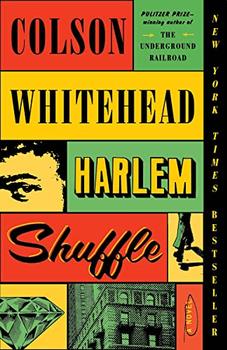Summary | Excerpt | Reading Guide | Discuss | Reviews | Beyond the book | Read-Alikes | Genres & Themes | Author Bio

From the two-time Pulitzer Prize-winning author of The Underground Railroad and The Nickel Boys, a gloriously entertaining novel of heists, shakedowns, and rip-offs set in Harlem in the 1960s.
"Ray Carney was only slightly bent when it came to being crooked..." To his customers and neighbors on 125th street, Carney is an upstanding salesman of reasonably priced furniture, making a decent life for himself and his family. He and his wife Elizabeth are expecting their second child, and if her parents on Striver's Row don't approve of him or their cramped apartment across from the subway tracks, it's still home.
Few people know he descends from a line of uptown hoods and crooks, and that his façade of normalcy has more than a few cracks in it. Cracks that are getting bigger all the time.
Cash is tight, especially with all those installment-plan sofas, so if his cousin Freddie occasionally drops off the odd ring or necklace, Ray doesn't ask where it comes from. He knows a discreet jeweler downtown who doesn't ask questions, either.
Then Freddie falls in with a crew who plan to rob the Hotel Theresa—the "Waldorf of Harlem"—and volunteers Ray's services as the fence. The heist doesn't go as planned; they rarely do. Now Ray has a new clientele, one made up of shady cops, vicious local gangsters, two-bit pornographers, and other assorted Harlem lowlifes.
Thus begins the internal tussle between Ray the striver and Ray the crook. As Ray navigates this double life, he begins to see who actually pulls the strings in Harlem. Can Ray avoid getting killed, save his cousin, and grab his share of the big score, all while maintaining his reputation as the go-to source for all your quality home furniture needs?
Harlem Shuffle's ingenious story plays out in a beautifully recreated New York City of the early 1960s. It's a family saga masquerading as a crime novel, a hilarious morality play, a social novel about race and power, and ultimately a love letter to Harlem.
But mostly, it's a joy to read, another dazzling novel from the Pulitzer Prize and National Book Award-winning Colson Whitehead.
Whitehead is a masterful writer, able to present characters and scenes that draw us in with fast-paced action, while also slowing down to provide enough gratifying and diverting details that allow us to enjoy the historical backdrop where the excitement unfolds. He is cerebral enough to pepper his deceptively simple prose with reflections upon double consciousness, race theory and criticisms of capitalism and privilege. At the same time, while we're entertained, surprised and intellectually stimulated by the novel's outstanding execution, somewhere a beating heart is missing. The novel is so plot-driven and filled with so much, that Whitehead overlooks delving into the rich internal lives...continued
Full Review
(650 words)
This review is available to non-members for a limited time. For full access,
become a member today.
(Reviewed by Jennifer Hon Khalaf).
 Harlem, a neighborhood in Upper Manhattan, was a crucial setting during the Civil Rights Era, which spanned approximately 1950 to 1964, arguably culminating with the passage of the controversial Civil Rights Act of 1964. The Great Migration in the early 20th century brought a considerable number of Black residents to the neighborhood, and it became a hotbed of cultural growth and political activism during the Harlem Renaissance in the 1920s and '30s. This period set the scene for the legal and social strides made during the revolutionary Civil Rights Era.
Harlem, a neighborhood in Upper Manhattan, was a crucial setting during the Civil Rights Era, which spanned approximately 1950 to 1964, arguably culminating with the passage of the controversial Civil Rights Act of 1964. The Great Migration in the early 20th century brought a considerable number of Black residents to the neighborhood, and it became a hotbed of cultural growth and political activism during the Harlem Renaissance in the 1920s and '30s. This period set the scene for the legal and social strides made during the revolutionary Civil Rights Era.
Harlem was the nexus for many important figures, places and key events in 20th-century Black history. Langston Hughes wrote many powerful poems while in Harlem, and Dr. Martin Luther ...
This "beyond the book" feature is available to non-members for a limited time. Join today for full access.

If you liked Harlem Shuffle, try these:

by Karen Valby
Published 2025
The forgotten story of a pioneering group of five Black ballerinas and their fifty-year sisterhood, a legacy erased from history—until now.

by William Boyle
Published 2025
As an Italian American family's decades-old secret begins to unravel, they will have to bear the consequences—and face each other—in this thrilling southern Brooklyn-set tragic opera of the highest caliber from crime fiction luminary William Boyle.
William Boyle is the master of Brooklyn-set crime ...
Flaming enthusiasm, backed up by horse sense and persistence, is the quality that most frequently makes for ...
Click Here to find out who said this, as well as discovering other famous literary quotes!